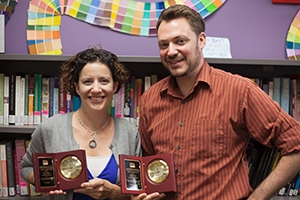In the Community
AU Educates the Feds on Inclusion

Bendoraitis and Bruno with commemorative gifts from the USDA. Photo by Patrick Bradley.
Revolution Televised
Sara Bendoraitis and Matt Bruno had given their Safe Space presentation dozens of times, but never in five states at once. That is, until June.
The two Center for Diversity & Inclusion staffers stood in front of a packed conference room at the U.S. Department of Agriculture’s Maryland office, where they were featured speakers for the organization’s first ever LGBT Pride Month celebration.
The pair’s message, on how to create an inclusive workplace, was live streamed to USDA offices as far away as Iowa and Arizona. “It demonstrated why these conversations are important, that the USDA put in so much effort to broadcast it,” Bruno explained. “It’s pretty cool that we impacted not just the people in the room but people in different parts of the country.”
That particular event counts as just one of the many trainings around diversity and inclusion that Bendoraitis and Bruno have conducted for various government agencies and nonprofit organizations—and it certainly won’t be the last.
Student Connection
Of CDI’s core programs, its signature Safe Space training series is perhaps its most celebrated and—increasingly—well known. Established in 2001 and open to AU students, staff, faculty, and community members, these trainings address everything from language around LGBT identities to issues affecting the community.
The success of these workshops at AU has translated into growing attention off campus. Since receiving calls in 2011 from both the USDA and the U.S. Naval Academy in Annapolis, Md., Bruno and Bendoraitis have presented workplace-tailored versions of Safe Space for groups ranging from the Department of Justice to the Nuclear Regulatory Commission.
The two are even working with the National Institutes of Health to develop the NIH's own Safe Space curriculum and program.
“Largely we’re talking about LGBT diversity in the workplace and how to create an inclusive climate around LGBT issues,” Bendoraitis explained. “We’ve been to some cool places.”
According to Bendoraitis, who is CDI’s director of programming, outreach, and advocacy, the secret to their success both on and off campus comes down to the reason she works in the field: students.
“Our students go and do great things at these organizations and then talk about the experiences they had at American,” she said. “We both have been able to put ourselves out there as a resource, and our students have been a great voice for us too.”
American Way
When Bruno, CDI’s coordinator of LGBTQ programming, speaks to a crowd of 50 to 75 federal employees, he thinks of AU. Consistently ranked and celebrated for its inclusivity, AU’s campus climate has spread beyond its boarders, due in large part to his own efforts.
“We’re able to do this work with outside organizations because we’re able to do this work at American,” he explained. “The ability for us to have a center that allows us to do 18 Safe Space workshops a year provides us a good foundation to then facilitate other LGBT workshops.”
Since 2001, on-campus Safe Space trainings have expanded to feature more targeted themes, including Unmasking Your Privilege, Trans 101, Paving the Way: Supporting First-Generation College Students, and Creating an Inclusive Community. With all these new titles, the center now offers AU an average of more than two trainings per week during the academic year.
Just as the university worked to foster its campus climate, Bendoraitis sees that government agencies are starting down the same path. “For a lot of folks, it’s the first time they’ve ever had an open dialogue about this,” she said.
With that in mind, Bendoraitis and Bruno will continue making their rounds both on and off AU soil, trying to open conversations and perspectives where possible.
Still, Bruno hopes that one day their presentation—and their faces—won’t need to be broadcast to offices across the country. One day, inclusion will just be a part of the national workplace.
“It reemphasizes how important the work we do on campus is,” he says. “All of these students are going into the workplace. If we can continuously talk to them about how to make more inclusive environments, whether it’s for LGBT people or not, they’re going into the workplace and changing it.”

